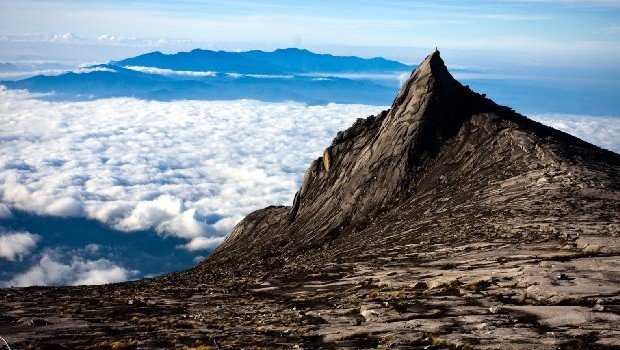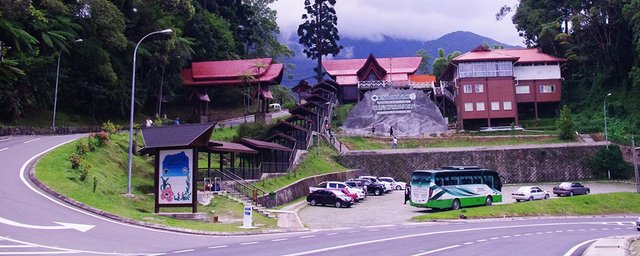About Mount Kinabalu
Mount Kinabalu’s specialty lies in its location at a renowned World Heritage Site—Kinabalu Park. Nature lovers will be delighted to be able to witness the many variations of flora and fauna that are to be found on the mountain at different altitudes.
Mount Kinabalu, along with other upland areas of the Crocker Range is well-known worldwide for its tremendous botanical and biological species biodiversity with plants of Himalayan, Australasian, and Indo-Malayan origin.
A recent botanical survey of the mountain estimated a staggering 5,000 to 6,000 plant species (excluding mosses and liverworts but including ferns), which is more than all of Europe and North America (excluding tropical regions of Mexico) combined. It is therefore one of the world’s most important biological sites.
Standing majestically at 4,095m (13,435 feet above sea level), Mount Kinabalu is the highest mountain between the Himalayas and New Guinea. Mount Kinabalu derives its name from the Kadazan word, ‘Aki Nabalu’, meaning ‘the revered place of the dead’. It is one of the safest and most conquerable peaks in the world—provided that you’re reasonably healthy and physically fit.

Mount Kinabalu is the most dramatic feature in Sabah and the tallest peak between the Himalayas & the New Guinea. Towering at 4,095 metres (13,435 feet), Mount Kinabalu exerts a magical quality that is both indescribable and unbelievable. The granite peaks are constantly veiled in wisps of clouds which sometimes resemble a graceful woman peeping coyly from behind the veil. At times during a clear day, the summit reveals a distinct glacier carved pinnacles, rising from the smooth granite dome, exuberating tranquility and peacefulness.
The mountain itself represents one of the world’s youngest batholiths: an old magna chamber that was forced through the earth’s crust. Though young, it is the central focus of Kinabalu Park and the legends of the KadasanDusun people, Sabah’s largest ethnic group. The KadasanDunsun believe that the mountain is the sacred resting ground of the spirits of their ancestors.

Legends & Myths – Mt Kinabalu Tale
There are many folklores and fables that tell stories of how Kinabalu got its name. The local KadazanDusun people believe that the word is derived from “Aki Nabalu”, which translates into “revered place of the dead”. The mysterious KadazanDusun tribe believes that spirits dwell on the mountain top. According to another popular folklore, the name Kinabalu actually meant “Cina Balu”. “Cina Balu” translates into “chinese widow”. Legend tells a story of a Chinese prince who ascends from the mountain in search of a huge pearl guarded by a ferocious dragon. He married a Kadazan woman upon his successful conquest, whom he soon abandoned for return to China. His heartbroken wife wandered into the mountains to mourn whereby eventually she turned into stone.

The average climber will take two days to climb up and down Mount Kinabalu. Climbers can choose from two available trails to climb Mount Kinabalu—the Summit trail and the Mesilau trail.
The Summit trail starts from the Timpohon Gate (1,800m; 5,906 ft) which is located near the Kinabalu Park Headquarters. Before reaching Panalaban (3,273m; 10,738 ft), climbers will encounter a series of trail shelters (pondok)—Pondok Kandis (1,981m; 6,499 ft), Pondok Ubah (2,095m; 6,873 ft), Pondok Lowii (2,286m; 7,500 ft), Layang-Layang (2,702m; 8,865 ft), Pondok Villosa (2,690m; 8,825 ft), and Pondok Paka (3,080m; 10,105 ft). The climb from Timpohon Gate to Panalaban takes approximately 6 to 8 hours.
Fitter and more adventurous climbers may otherwise, opt for the Mesilau trail which starts at the Mesilau Nature Resort, 15 kilometers (9.32 miles) away from the Kinabalu Park Headquarters. This trail is particularly steep and slippery especially during the wet seasons. However, its longer route is suitable for scientist and researchers who are keen to analyze Mount Kinabalu’s ecology.
Along the trails, be sure to keep your eyes open for the plenteous interesting sights to check out such as the Villosa pitcher plant as well as a view of the Carson miniature waterfall.
Upon arriving at Panalaban, climbers will have some time to rest and recharge their energy. The climb to the summit resumes before dawn, normally at 2am the next morning. The climb to reach the summit requires climbers to hold onto a rope. Therefore, climbers are advised to wear thick woven gloves in order to ward off the cold as well as to prevent their palms from getting cuts. The climb from Panalaban to the summit normally takes 4 to 5 hours.
Another exciting way to conquer Mount Kinabalu is through the Mountain Torq Via Ferrata trail.

Kinabalu Park – A World Heritage Site
On the rainforest-clad island of Borneo lies Kinabalu Park, Malaysia’s first World Heritage Site declared by UNESCO. Kinabalu Park was established in 1964 to protect Mount Kinabalu and its plant and animal life. The biggest attraction in Kinabalu Park would be Mount Kinabalu, one of the world’s most prominent mountains, and the Mount Kinabalu Botanical Garden. Kinabalu Park is a scenic 2-hour drive from Kota Kinabalu, the capital of Sabah. The Park covers an area of 754 square kilometers (291 square mile), has four climatic zones and also one of the richest collections of flora and fauna in the world.
The gateway to the mountain is the Kinabalu Park Headquarters, situated 1,563 metres on its southern boundary. A variety of accommodation, restaurants and an exhibition centre are available here. This is also where visitors pay the entrance fee to the park and register if they are a climber. Visitors can explore the Mountain Garden on their own or join the park’s naturalist on a guided walk along the many trails available.
About Kinabalu Park
Kinabalu Park was established as one of the first national parks in Malaysia in 1964. It is also Malaysia’s first World Heritage Site designated by UNESCO in December 2000 for its ‘outstanding universal values’ and the role as one of the most important biological sites in the world, housing more than 4,500 species of flora and fauna – including 326 bird species, an estimated of over 100 mammal species and over 110 land snail species.
Located on the west coast of Sabah, Malaysian Borneo, Kinabalu Park covers an area of 754 square kilometres surrounding Mount Kinabalu, which at 4,095.2 metres, is the highest mountain on the island of Borneo. Kinabalu Park is one of the most popular tourist spots in Sabah and Malaysia in as a whole. Thousands of visitors come to Sabah annually to climb Mount Kinabalu and to experience the mystical beauty of its nature.
Kinabalu Park was discovered by British colonial administrator and naturalist, Hugh Low in 1895, during a serendipitous expedition from Tuaran to Kundasang. Sir Hugh Low is also the first recorded man to reach the peak of Mount Kinabalu and the highest peak of the mountain – Low’s Peak – is named in his honour.
Downvoting a post can decrease pending rewards and make it less visible. Common reasons:
Submit